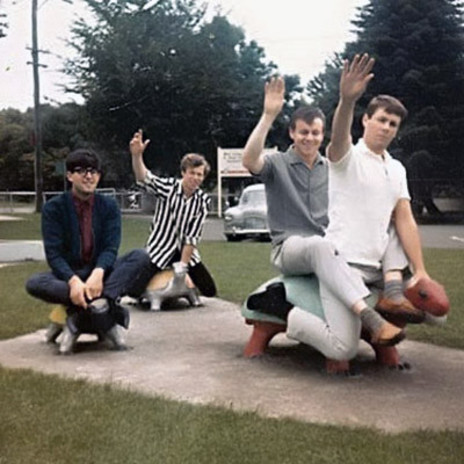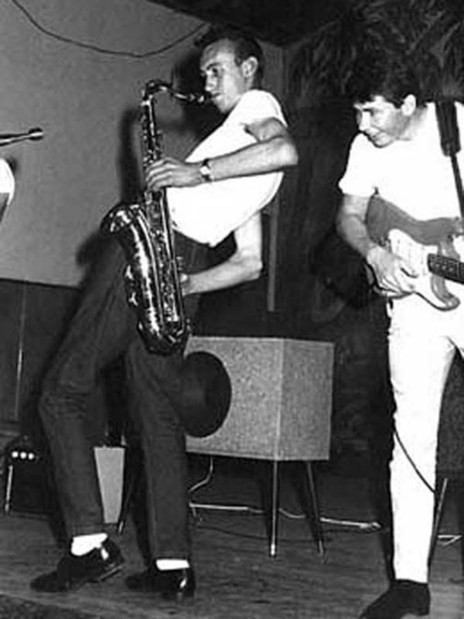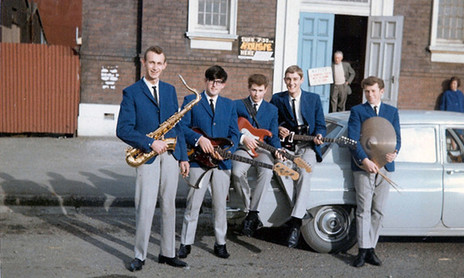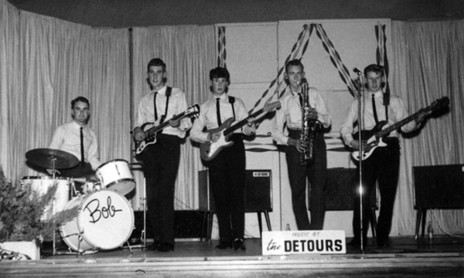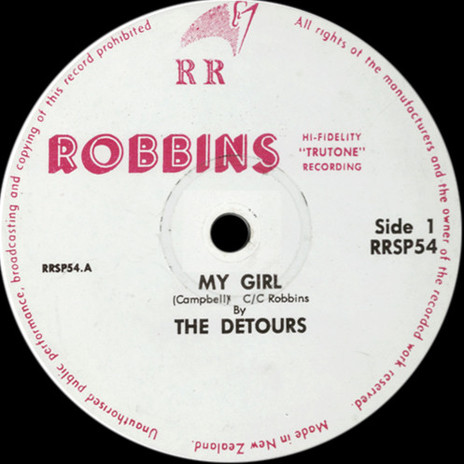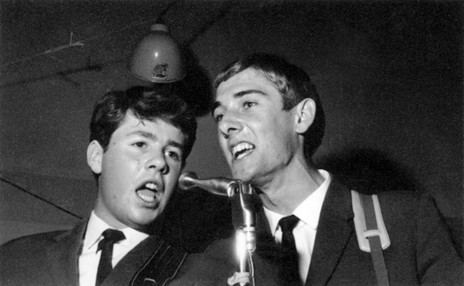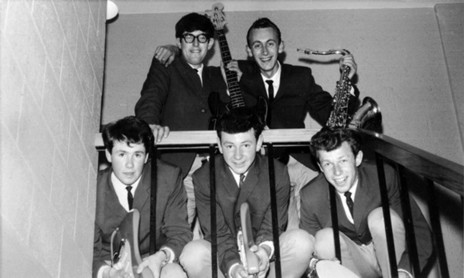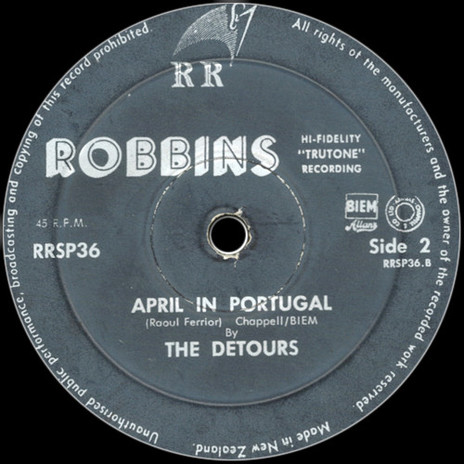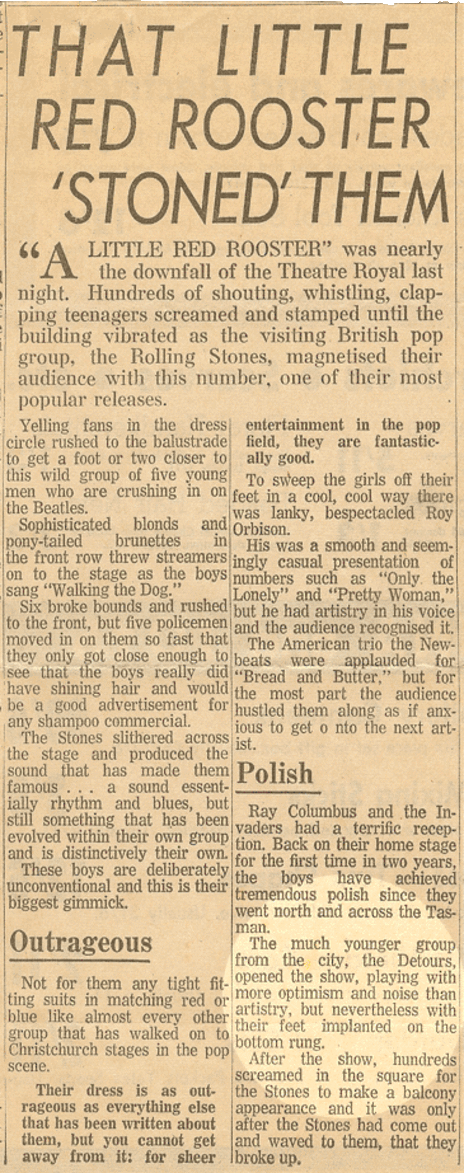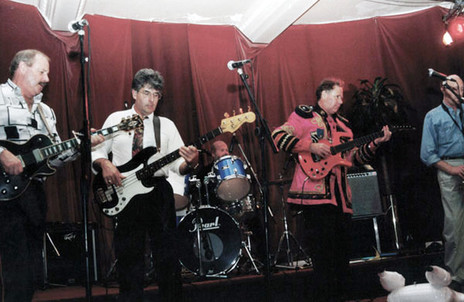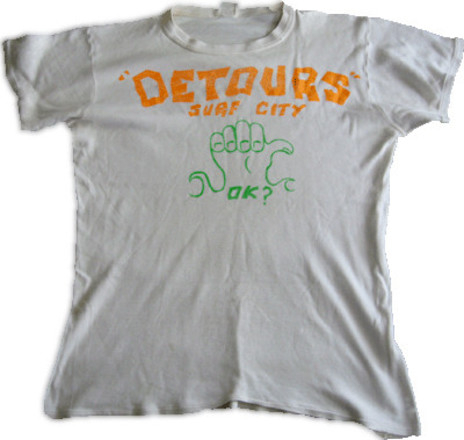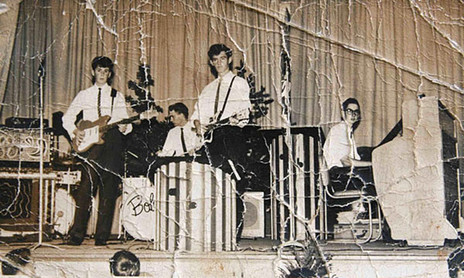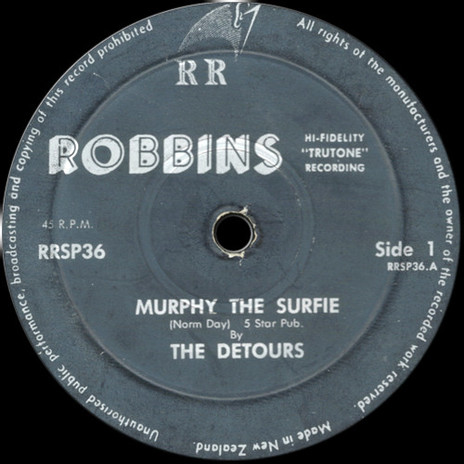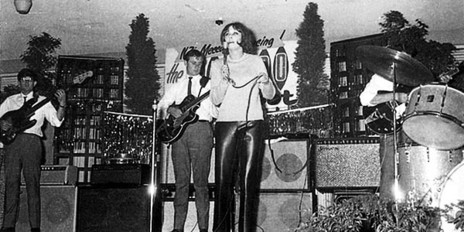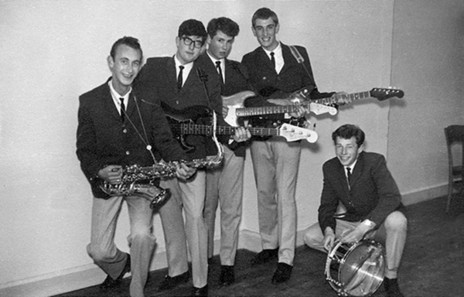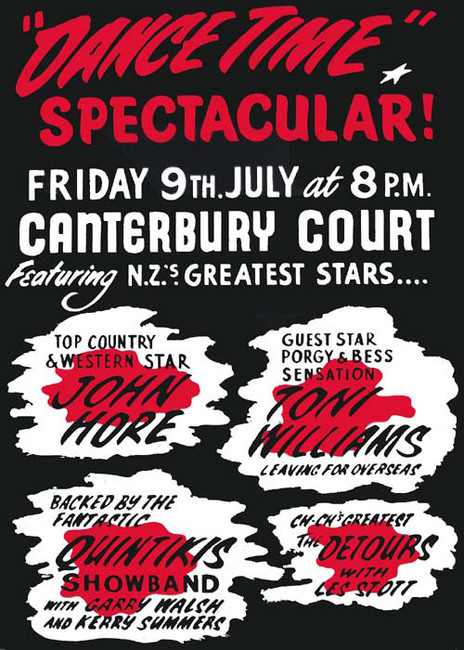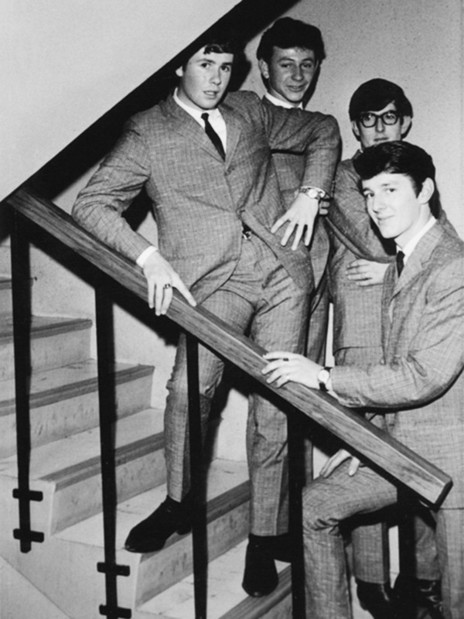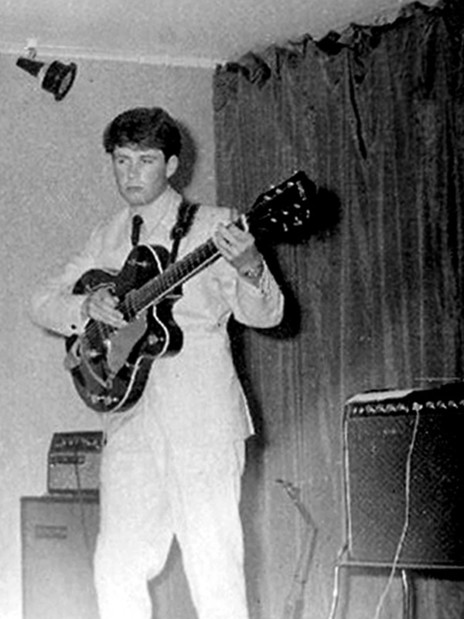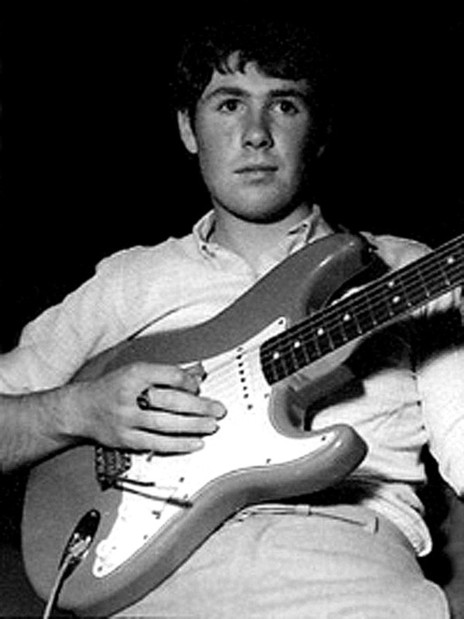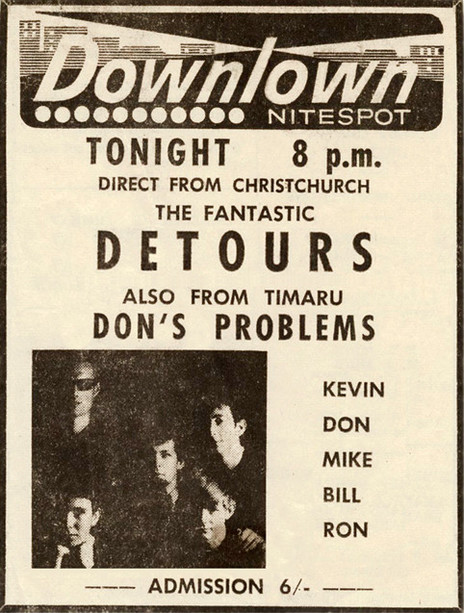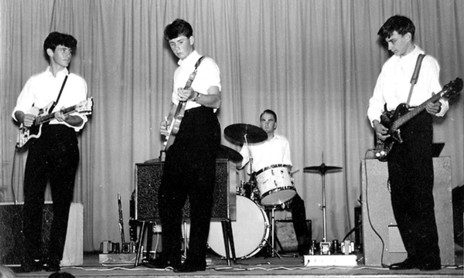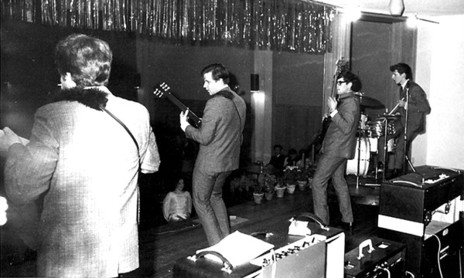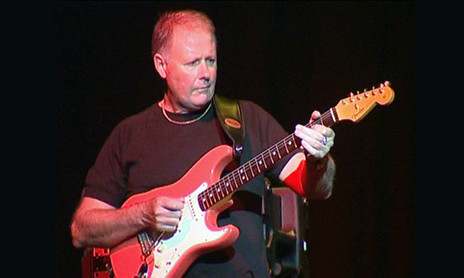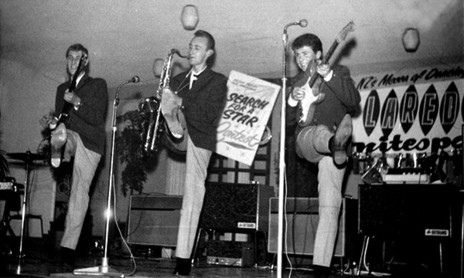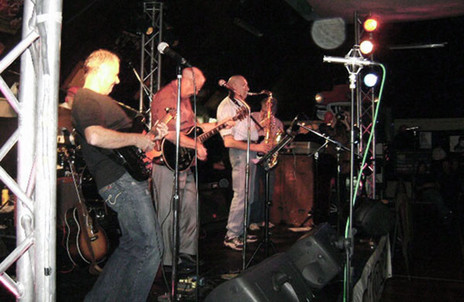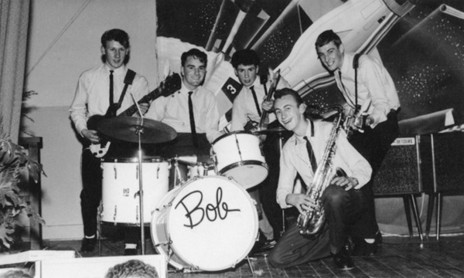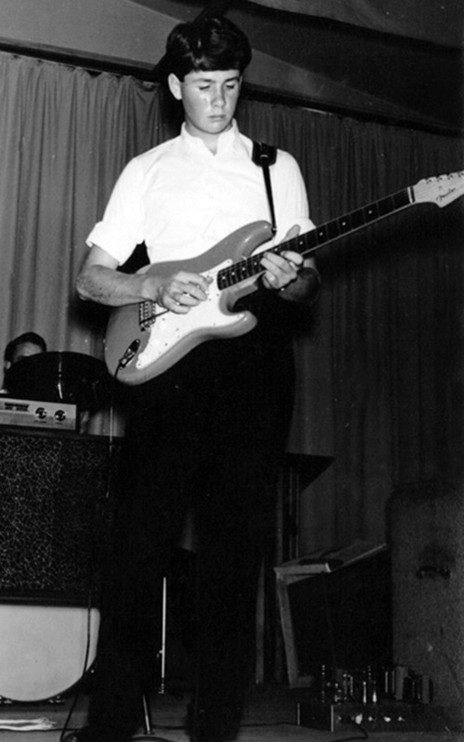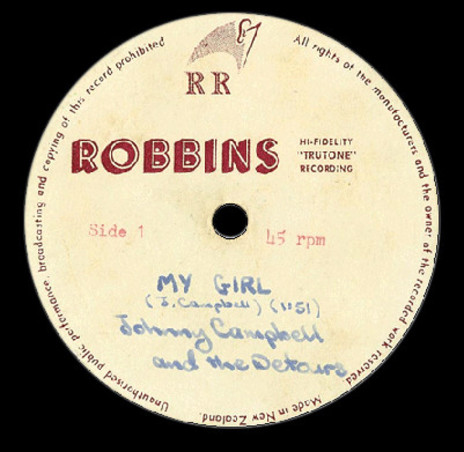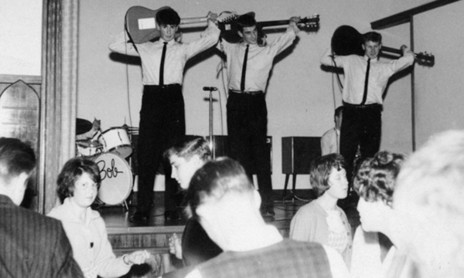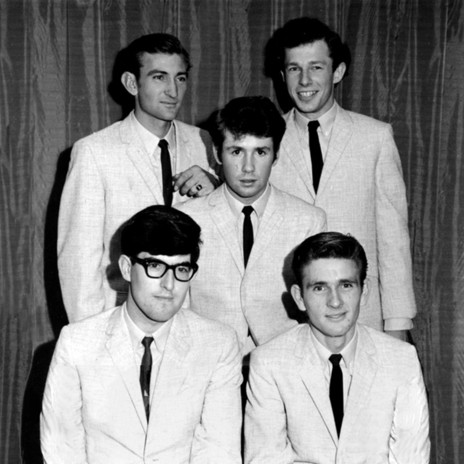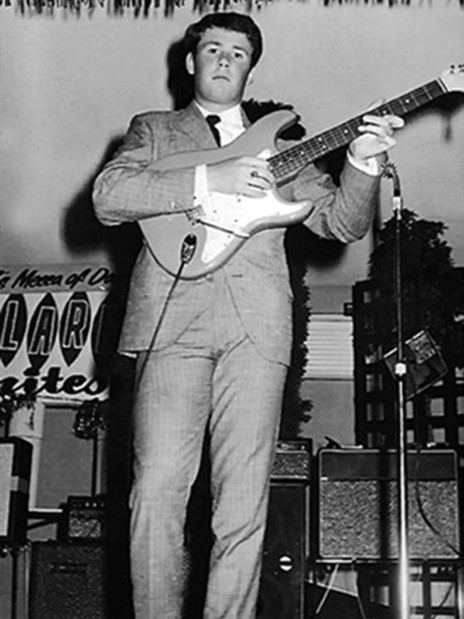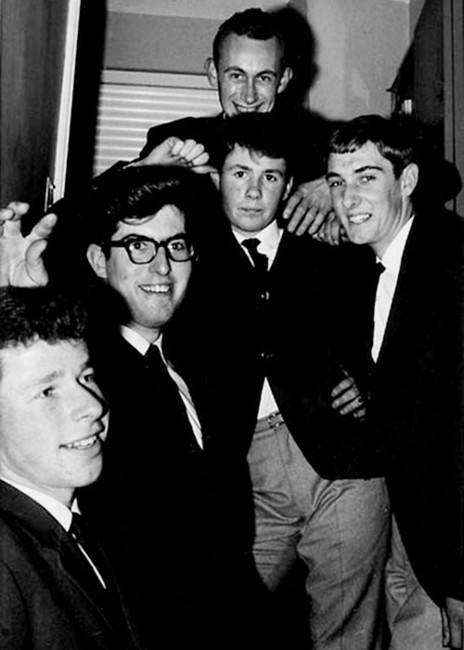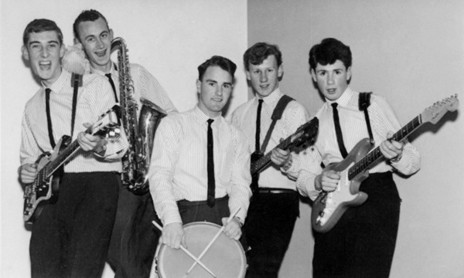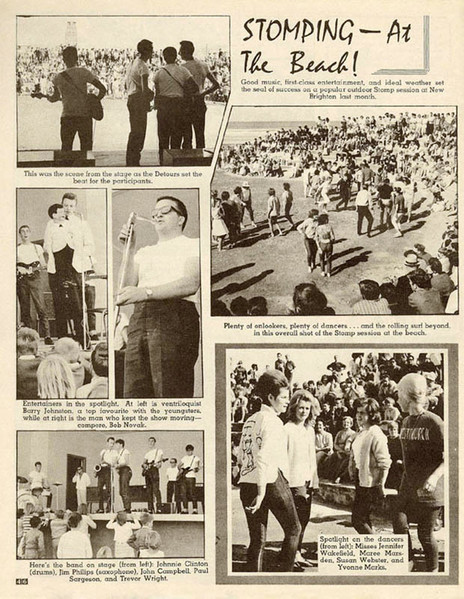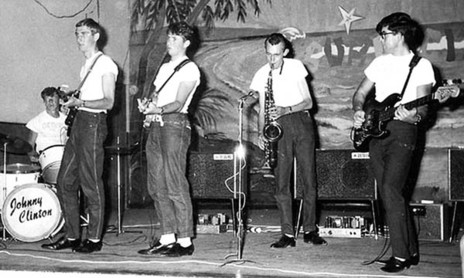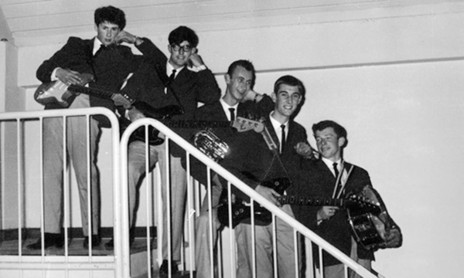When Christchurch teenager Johnny Campbell heard the Shadows’ smash single ‘Apache’ on 3ZB, he was captivated by the sound, and began to develop and hone his fingerboard skills on the ukulele.
His first guitar was a Futurama III, soon replaced by a new 1962 Fiesta Red Fender Stratocaster. He was also learning modern piano from local bandmaster Bob Bradford; this tuition provided him with a good understanding of chord structures and musical notation, building on his musical experience as a Cathedral chorister.
The first serious attempt at putting a band together was with The Torments, which was formed in late 1962/1963 and featured female vocalist Judith Turtill. Her boyfriend at the time, Garry “Gus” Mulholland, was on rhythm guitar, his brother Peter on piano, Bob Barrett on drums, and Michael Robinson on bass. Sunday nights would see the group playing at the Friendship House Coffee Club on Cambridge Terrace, Christchurch, but Garry soon decided to leave.
The lineup of Johnny Campbell, Paul Sargison, Bob Barrett, Michael Robinson and Jim Phillips solidified into The Detours. The name was taken from The Ventures’ song ‘Detour’: at that point, Johnny, who chose the name, was unaware that there were at least two groups called “Detours” operating in Europe. The most famous of these went on to become The Who.
Johnny and Bob were still at Shirley Boy’s High School when The Detours started to happen, and the band soon featured on the Christchurch entertainment scene, with the first serious lineup solidifying by early 1963. This lineup was working regularly on the local church dance and club circuit when the group entered the local CHTV3’s Have A Shot television talent quest. They performed ‘April in Portugal’, which would be the flip-side of their first commercial release, ‘Murphy The Surfie’ for Robbins Recordings.
As The Detours’ popularity grew, and bookings became more substantial, the group secured many prestigious jobs in the Christchurch area, with the ultimate church gig of the period falling to them after Max Merritt and The Meteors departed town. Not only was the dance at St Mary’s Merivale the prize job, but The Detours soon took over Max Merritt’s parents’ Christchurch Teenagers Club Sunday gig at the Railway Hall in Carlyle Street.
Prior to their first commercial release, The Detours recorded a couple of tracks with a fledgling lineup that included school friend Jimmy Phillips on saxophone; Kevin Nicholls, an older friend, played rhythm guitar. The studio outing was a good exercise for the nucleus of the group, and the tunes were ‘Buckeye’ (by Johnny and the Hurricanes) and ‘Lessons In Love’ (Cliff Richard), and only one acetate was manufactured.
The Detours soon had two new faces in the lineup with Trevor Wright on bass guitar and Paul Sargison’s cousin, John Clinton, on drums.
The first major break for group was in 1963, a residency at the new Surf City in South Brighton.
Once the band established a reputation as a polished and reliable act, many specialist events became available, and one such venture was the Al-Di-La weekly dance held at the St John Ambulance Hall in Peterborough Street, Christchurch. The band’s involvement was brief but the experience soon led to future residencies.
The first major break for group was in mid-late 1963 when they secured the residency at the new Surf City in the Pleasant Point Domain Hall at South Brighton, Christchurch. Surf City was conceived by Australian ex-professional wrestler, Bob Novak – who wanted to establish franchises – and was bankrolled by Dick Jamieson, the owner and operator of the ritzy local American Health Studios.
Around the same time the Surf City residency was coming to fruition The Detours recorded two numbers featuring the Campbell, Sargison, Robinson, Clinton, Phillips lineup, with ‘April In Portugal’ being the intended A-side, and ‘My Blue Heaven’ the flip. This combination, however, never made it to release, as the band became aware of an infinitely more topical, surf-oriented number: ‘Murphy The Surfie’, written by The Joy Boys’ lead guitarist Norm Day. As it turned out, and for totally unknown reasons, bass player Mike Robinson never made it to the ‘Murphy The Surfie’ recording session.
In the Robbins control room that night, Keith Robbins was blowing bubbles through a straw into a glass to represent the wiped-out Murphy. For an unknown reason, bass player Mike Robinson wasn’t present, so Robbins was blowing bubbles, a bass line was dubbed in by Johnny, using his thumb-picked Stratocaster on the neck pickup with the tone control on full treble cut.
The Detours’ reputation grew dramatically during the Surf City era, and a significant (and very loyal) fan-base built up. The Surf City residency included a tour to New Plymouth for gigs in the local sports hall, and this was great for the band. By now it was a very stable five-piece, with John Clinton on drums and Trevor Wright on bass.
The Detours worked very hard to make their point of difference in the competitive world of weekend gigs on the Christchurch scene, and it paid off as they built a strong following from within the surfing community. The promoters of Surf City went out of their way to cater for the surfing community so the venue was always extremely well supported by surfers, and young people in general.
When Harry M. Miller’s Surfside 64 show came to town – featuring Roy Orbison, the Beach Boys, and others – Bob Novak, who acted as The Detours’ manager and knew one of Miller’s friends, arranged for The Detours to set up their gear at the friend’s house in Merivale, Christchurch. After the show, all the performers came to the Merivale address for a free-for-all session with nearly everyone there taking turns to play or sing during the course of the evening. Eventually they moved to The Shirley Lodge Motor Hotel, where the performers were staying. Johnny recalls having Dennis Wilson and Mike Love of the Beach Boys in the back seat of his 1949 side-valve Morris Minor heading over to Shirley Lodge. (Johnny recalls Dennis saying how they had written a million-selling song about his old 1932 Ford Model B Coupé – ‘Little Deuce Coupe’.)
Campbell finished school at the end of 1965, and one of the first jobs for The Detours in the new year was the annual students’ orientation party at the Addington Racecourse. Later in the year the band secured the prestigious Laredo residency, as second stringers to The Playboys, who were Auckland-bound (and reinvented themselves as Dave Miller and The Byrds).
The Laredo Nightspot was Christchurch’s No.1 dance attraction of the day, and it was always very well patronised. Saturday nights were a standing-room-only affair that featured many of New Zealand’s major pop acts. The venue for The Laredo was the now-demolished Horticultural Society Hall, entered off Cambridge Terrace. It was run by a natural gentleman, Jimmy Rhydings, and his wife, and it was a well-organised and happy environment for the bands working there. The hall was well appointed and fitted out with a state-of-the-art Philips PA system. There was a hierarchical structure within the resident bands; the top bands enjoyed the best time slots and backed artists, but there was great camaraderie between bands.
The Detours came from a surf/stomp culture at Surf City, and were soon aware of the need to keep a close eye on the pop charts for hit songs to add to their already extensive repertoire. They played two nights a week, after practising for two evenings in Johnny’s parents’ lounge. A uniform added to their sophistication: light-grey tailored trousers and handmade blue jackets.
A night at the Laredo included mini talent contests and “star searches”, but for The Detours the real buzz came when they gravitated to the top slot. This meant they backed New Zealand stars such as Howard Morrison, Rochelle Vinsen, Jim McNaught, The Librettos, Peter Posa, Allison Durbin, Gwynn Owen, Tommy Adderley, Yolande Gibson, John Hore, Toni Williams, Anne Murphy, Ray Woolf, and Ray Columbus.
The Detours became more of a R&B band, and a feature of their set was Chuck Berry’s ‘Carol’.
The Detours became more of a rhythm and blues band, and a feature of their set was Chuck Berry’s ‘Carol’, which the band performed to their own recorded hand claps, and the Kinks’ ‘You Really Got Me’.
Having invested in a full set of very snappy grey suits for the Laredo, The Detours stayed casual for the Carlyle Street Youth Club dances on a Sunday afternoon. Max Merritt’s parents commanded great respect from the rock’n’roll fraternity and visiting artists came by often. On one occasion the guests were from the touring Peter Posa Show: Posa himself, Dinah Lee, and her fashion mentor, model Jackie Holme, Max Merritt’s girlfriend at the time (she created Lee’s mod hairstyle, and introduced her white leather boots).
In line with the established pecking order, and with The Detours now resident as top group at The Laredo, newcomers The Vigilantes came in as second band. The Detours were now a four-piece: Brian Bligh on rhythm guitar, Johnny Campbell on lead, Trevor Wright on bass and John Clinton on drums.
Campbell’s girlfriend was undeniably The Detours’ greatest fan of the day, and it’s not entirely surprising that she was the inspiration for the band’s hit single ‘My Girl’, which was written by Campbell in his final year at Shirley Boys’ High School in 1964. Released in 1965, the single was particularly strong in the Hamilton area for some unknown reason. In those days, radio’s Lever Hit Parade was the gauge by which records stood or fell, and each area had its own locally produced 30-minute programme each week. Sadly, ‘My Girl’ received no serious attention from the prestigious, nationally syndicated, Lever Hit Parade.
John Clinton moved to Whanganui with his family, and his temporary replacement on drums was Graham Hanham. He added a solid polish to the group, which was at that stage focused on quality instrumental music, especially by The Shadows, but even to diverse showpieces such as ‘Baby Elephant Walk’ and ‘El Cumanchero’. There was also a major trend towards group-harmony vocals from emerging groups such as Brian Poole and The Tremeloes and The Beatles. This style was increasingly included in The Detours’ repertoire.
Trevor King arranged with Harry M. Miller for The Detours to open the Christchurch concert of the Rolling Stones’ tour at the Theatre Royal in February 1965. Campbell and Brian Bligh were at the movies in the afternoon and an usher came with a message for them to contact King for very good news. Playing to a packed theatre was a very nervous time for the band. Trevor Wright had to beg to use Bill Wyman’s bass amplifier; he reluctantly agreed. The show kicked off with The Detours playing Manfred Mann’s ‘Do Wah Diddy Diddy’ which was a huge hit and gaining lots of airplay at that time. The concert review indicated that The Detours were suitably well received but alas not musically impressive enough to register on the reviewer’s buzz scale.
The Detours enjoyed an excellent camaraderie on and off stage, with a very stable lineup.
The Detours enjoyed an excellent camaraderie on and off stage, with a very stable lineup. Sadly, Brian Bligh – a key player through the band’s halcyon days – had to quit the group due to National Service. He was replaced by the virtuoso Larry McKay, formerly with The Vigilantes. DanceTime Spectacular! at Canterbury Court was Brian’s last performance, and saw the band focusing on the current Mersey-type sounds rather than the big-echo instrumental material for which they were well known. John would turn his back on his beloved Fiesta Red Fender Stratocaster, and Larry his equally loved Gibson ES335 TDC, for Beatles-inspired Gretsch Tennesseans.
Larry McKay was an inspirational, highly spirited player, and he and Campbell clicked musically. The band started to perform complex numbers which showcased both guitarists’ techniques, and allowed for interactions and harmonies between them. This was a very creative era for the band, and one in which the sound became very tight and polished. There is no doubt that the new wave of bands writing collaboratively, and the increasing sophistication of group sounds in general, had an impact on The Detours at that time.
‘Walk With Me’ was Larry’s baby. John came up with the suspension introduction, along with the lead embellishments. At band practice the completed song was presented to Trevor and Graham who added their own various parts, and response harmonies were introduced. Trevor’s walking bass is particularly catchy, and the song was regularly in The Detours’ set-list. The track was recorded at Robbins in one evening only, with only a rough vocal. The project was never completed.
Timaru had been crying out for its own piece of nightlife, and The Downtown Nitespot was the name chosen for a new Stafford Street venue, organised by local second-hand dealer Ray Wright. The Detours were chosen as the out-of-town headline act to open the club, and the job meant that for several weeks, the group drove 100 miles to Timaru each Friday afternoon, to be ready to play that night.
Over the summer of 1965-1966 The Detours were engaged for an exclusive summer gig at The Blue Moon, Paraparaumu Beach, north of Wellington. This three-week job was an amazing experience for the band which, for this engagement, was joined by The Vigilantes’ vocalist Dixon McIvor. The deal was that the band would live in Paraparaumu in a house that was walking distance to the venue, near the beach. As it was the only dance in the area, and ran almost every night over the holidays, excellent crowds were guaranteed.
Despite best efforts with limited security from the promoters, there were frequent eruptions in and around the hall, and this was a concern for the band. The support act was Tommy Kahi’s all-girl band The Chikadees.
Johnny Campbell, Trevor Wright, and John Clinton decided to join forces with Peter and Paul Talbot (ex-Peter, Paul and The Pursuers) to form what was to be the last ever Detours lineup, and to accept a residency at the Mecca Nitespot (formerly The Safari Lounge and The Scene, located upstairs on Tuam Street). They purchased new suits, and a series of publicity pictures was taken to publicise their new existence at The Mecca.
At the new residency, The Detours began changing their style to maximise the vocal impact of Peter and Paul, who were superb harmonists. Ultimately this took the group away from its instrumental strengths, and it was soon apparent that the new venue and new-look band would soon part company.
One night in July 1966, a practice session at the Mecca, Campbell came to the conclusion that his brief musical career should come to an end. He loaded his equipment into his 1949 side-valve Morris Minor and headed off into the sunset to seek his fortune in the big bad commercial world.
--
In April 1997 The Detours performed together for the first time in 31 years, for John R Campbell’s 50th birthday. In 2006 many of the musicians and bands from the early 60s Christchurch scene performed in the Spencer Street Revisited concerts in the Christchurch Cathedral. Among them were Ray Columbus, Phil Garland, Peter Nelson and the Castaways, and John R Campbell. Recordings by The Detours have been featured on several compilations on the Frenzy label, which also released, in 2019, a Johnny Campbell and The Detours CD compilation: Overtime: the Essential Recordings, 1963-2019. The material includes tapes recorded at home in the 60s, the Robbins sessions, plus more recent material by Campbell. Many of these can be heard on the Johnny Campbell website, and Spotify.
